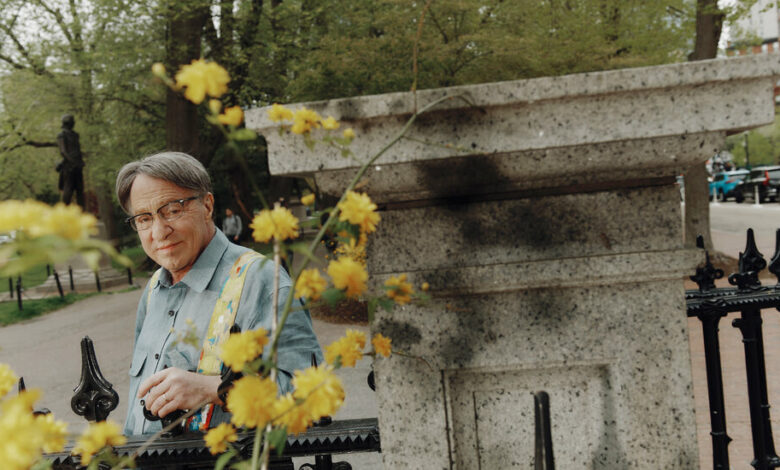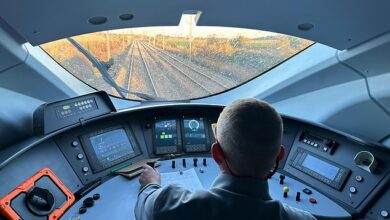Ray Kurzweil Still Says He’ll Merge With AI

Ray Kurzweil sat by a window in Boston’s Four Seasons Hotel, overlooking a duck pond in the city’s Public Garden. He held up a sheet of paper charting the steady growth in the amount of raw computing power a dollar can buy over the past 85 years.
A neon green line rose steadily across the page, like fireworks in the night sky.
That diagonal line, he said, showed why humanity was only 20 years away from the Singularity, a long-awaited moment when humans will merge with artificial intelligence and augment themselves with millions of times more computing power than their biological brains now provide.
“When you create something that is thousands of times — or millions of times — more powerful than the brain, we can’t predict what it’s going to do,” he said, wearing multicolored suspenders and a Mickey Mouse watch he bought at Disney World in the early 1980s.
Mr. Kurzweil, a renowned inventor and futurist who built a career on predictions that defy conventional wisdom, made the same claim in his 2005 book, “The Singularity Is Near.” With the advent of AI technologies like ChatGPT and recent efforts to implant computer chips in people’s heads, he believes the time is ripe to repeat his claim. Last week, he published a follow-up, “The Singularity Is Nearer.”
Now that Mr. Kurzweil is 76 and moving much slower than he used to, his predictions have an extra edge. He has long said that he plans to experience the Singularity, merge with AI and live that way indefinitely. But if the Singularity arrives in 2045, as he claims, there is no guarantee that he will see it.
“Even a healthy 20-year-old could die tomorrow,” he said.
But his prediction isn’t as outlandish as it seemed in 2005. The success of the ChatGPT chatbot and similar technologies has prompted many leading computer scientists, Silicon Valley executives, and venture capitalists to make outrageous predictions about the future of AI and how it will change the course of humanity.
Tech giants and other deep-pocketed investors are pouring billions into developing AI, and the technologies are becoming more powerful every few months.
Many skeptics warn that extravagant predictions about artificial intelligence could come crashing down as the industry grapples with the limits of the raw materials needed to build AI, including electricity, digital data, mathematics and computing power. Techno-optimism may also feel shortsighted — and privileged — in the face of the world’s many problems.
“When people say AI will solve every problem, they’re not really looking at the root causes of those problems,” says Shazeda Ahmed, a researcher at the University of California, Los Angeles, who studies claims about the future of AI.
The big step, of course, is to imagine how human consciousness would merge with a machine. People like Mr. Kurzweil have a hard time explaining exactly how this would happen.
Born in New York City, Mr. Kurzweil began programming computers as a teenager, when computers were still room-sized machines. In 1965, at the age of 17, he appeared on the CBS television show “I’ve Got a Secret,” playing a piano piece composed by a computer he designed.
While still a student at Martin Van Buren High School in Queens, he exchanged letters with Marvin Minsky, one of the computer scientists who founded the field of artificial intelligence at a conference in the mid-1950s. He soon enrolled at the Massachusetts Institute of Technology to study under Dr. Minsky, who had become the face of this new academic pursuit—a mix of computer science, neuroscience, psychology, and an almost religious belief that thinking machines were possible.
When the term artificial intelligence was first introduced to the public at a 1956 conference at Dartmouth College, Dr. Minsky and the other computer scientists there thought that it would not take long to build machines that could match the power of the human brain. Some claimed that a computer would beat the world chess champion and discover its own mathematical theorem within a decade.
They were a bit too optimistic. A computer would not beat the world chess champion until the late 1990s. And the world is still waiting for a machine to discover its own mathematical theorem.
After Mr. Kurzweil founded a series of companies that developed everything from speech-recognition technology to music synthesizers, President Bill Clinton awarded him the National Medal of Technology and Innovation, the nation’s highest honor for achievement in technological innovation. His profile continued to rise as he wrote a series of books predicting the future.
Around the turn of the century, Mr. Kurzweil predicted that AI would match human intelligence by the late 2020s and that the Singularity would follow 15 years later. He reiterated these predictions when the world’s leading AI researchers gathered in Boston in 2006 to celebrate the field’s 50th anniversary.
“There was polite snickering,” said Subbarao Kambhampati, an AI researcher and professor at Arizona State University.
AI began to improve rapidly in the early 2010s when a group of researchers at the University of Toronto investigated a technology called a neural network. This mathematical system could learn skills by analyzing large amounts of data. By analyzing thousands of photos of cats, it could learn to identify a cat.
It was an old idea, dismissed decades earlier by people like Dr. Minsky. But it was beginning to work in illuminating ways, thanks to the vast amounts of data the world had uploaded to the Internet — and the advent of the raw computing power needed to analyze it all.
The result, in 2022, was ChatGPT. It was driven by that exponential growth in computing power.
Geoffrey Hinton, the University of Toronto professor who helped develop neural network technology and is perhaps more responsible for its success than any other researcher, once dismissed Kurzweil’s prediction that machines would surpass human intelligence by the end of the decade. He now believes it was insightful.
“His prediction doesn’t look so crazy anymore. Things are happening much faster than I expected,” said Dr. Hinton, who until recently worked at Google, where Mr. Kurzweil has led a research group since 2012.
Dr. Hinton is among AI researchers who believe that the technologies powering chatbots like ChatGPT could become dangerous — perhaps even destroy humanity. But Mr. Kurzweil is more optimistic.
He has long predicted that advances in AI and nanotechnology, which can alter the microscopic mechanisms that control the behavior of our bodies and the diseases that afflict them, will counter the inevitability of death. Soon, he said, these technologies will extend lives faster than people age, eventually reaching an “escape velocity” that will allow people to extend their lives indefinitely.
“By the early 2030s, we will no longer die from aging,” he said.
If he can reach this moment, Mr. Kurzweil explained, he can likely reach the Singularity as well.
But the trends that anchor Mr. Kurzweil’s predictions — simple line graphs that show the growth of computing power and other technologies over long periods of time — don’t always continue in the way people expect, said Sayash Kapoor, a researcher at Princeton University and co-author of the influential online newsletter “AI Snake Oil” and a book of the same name.
When a New York Times reporter asked Mr. Kurzweil in 2013 whether he predicted immortality for himself, he replied, “The problem is, I can’t get on the phone to you in the future and say, ‘Well, I did it, I lived forever,’ because it’s never forever.” In other words, he could never be right.
But he could be wrong. Sitting by the window in Boston, Mr. Kurzweil acknowledged that death comes in many forms. And he knows his margin for error is shrinking.
He recalled a conversation with his aunt, a psychotherapist, when she was 98. He explained his theory of lifespan escape velocity—that humans will eventually reach a point where they can live indefinitely. She replied, “Can you please hurry up with that?” Two weeks later, she died.
While Dr. Hinton is impressed by Mr. Kurzweil’s prediction that machines will be smarter than humans by the end of the decade, he is less enamored with the idea that the inventor and futurist will live forever.
“I think a world run by 200-year-old white men would be a horrible place,” Dr. Hinton said.
Audio produced by Patricia Sulbaran.





